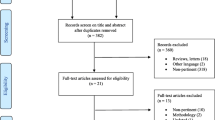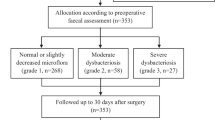Abstract
Background
The dysbiosis is defined as a disturbed symbiotic relationship between microbiota and the host and can cause a pro-inflammatory imbalance impairing the healing process at anastomotic level. The aim of this study is to detect, in fecal samples collected in the preoperative time, a peculiar microbiota composition that could predict the onset of colorectal anastomotic leakage.
Materials and methods
We compared gut microbiota of healthy patients (Group A) and patients with colorectal cancer eligible for surgery (Group B). Group B was divided into patients who developed anastomotic leak (Group BL) and patients who had uneventful recovery (Group BNL). Stool samples were collected before surgery and after neoadjuvant treatment.
Results
We analyzed stool samples from 48 patients, 27 belonging to Group A and 21 to Group B. In Group B, five patients developed anastomotic leakage (Group BL). Compared to healthy subjects, Group B showed a moderate increase of Bacteroidetes and Proteobacteria, a moderate reduction of Firmicutes and Actinobacteria, and a statistically significant reduction of Faecalibacterium prausnitzii. Group BL patients showed an array of bacterial species which promoted dysbiosis, such as Acinetobacter lwoffii and Hafnia alvei. Group BNL patients showed that bacterial species like Faecalibacterium prausnitzii and Barnesiella intestinihominis have a protective function.
Conclusions
The bacterial flora in subjects with colorectal cancer is statistically different compared to healthy patients. The presence of preoperative aggressive bacteria and the lack of protective strains has strengthened the hypothesis that a peculiar microbiota composition could represent a risk factor for the occurrence of anastomotic leakage.







Similar content being viewed by others
References
Abdulamir AS, Hafidh RR, Abu BF (2011) The association of Streptococcus bovis/gallolyticus with colorectal tumors: the nature and the underlying mechanisms of its etiological role. J Exp Clin Cancer Res 30:11. https://doi.org/10.1186/1756-9966-30-11
Chang AH, Parsonnet J (2010) Role of bacteria in oncogenesis. Clin Microbiol Rev 23:837–857. https://doi.org/10.1128/CMR.00012-10
Gagniere J, Raisch J, Veziant J, Barnich N, Bonnet R et al (2016) Gut microbiota imbalance and colorectal cancer. World J Gastroenterol 22:501–518. https://doi.org/10.3748/wjg.v22.i2.501
Nistal E, Fernandez-Fernandez N, Vivas S, Olcoz JL (2015) Factors determining colorectal cancer: the role of the intestinal microbiota. Front Oncol 5:220. https://doi.org/10.3389/fonc.2015.00220
Sekirov I, Russell SL, Antunes LC, Finlay BB (2010) Gut microbiota in health and disease. Phys Rev 90:859–904. https://doi.org/10.1152/physrev.00045.2009
Gao Z, Guo B, Gao R, Zhu Q, Qin H (2015) Microbiota dsbiosis is associated with colorectal cancer. Front Microbiol 6:20. https://doi.org/10.3389/fmicb.2015.00020
Thursby E, Juge N (2017) Introduction to the human gut microbiota. Biochem J 474:1823–1836. https://doi.org/10.1042/BCJ20160510
Yu YN, Fang JY (2015) Gut Microbiota and colorectal cancer. Gastrointest Tumors 2:26–32. https://doi.org/10.1159/000380892
Lucke K, Miehlke S, Jacobs E, Schuppler M (2006) Prevalence of Bacteroides and Prevotella spp. In ulcerative colitis. J Med Microbiol 55:617–624
Tjalsma H, Boleij A, Marchesi JR, Dutilh BE (2012) A bacterial driver-passenger model for colorectal cancer: beyond the usual suspects. Nat Rev Microbiol 10:575–582. https://doi.org/10.1038/nrmicro2819
Lucas C, Barnich N, Nguyen HTT (2017) Microbiota, inflammation and colorectal cancer. Int J Mol Sci 18:E1310. https://doi.org/10.3390/ijms18061310
Chen W, Liu F, Ling Z, Tong X, Xiang C (2012) Human intestinal lumen and mucosa-associated microbiota in patients with colorectal cancer. PLoS ONE 7:e39743. https://doi.org/10.1371/journal.pone.0039743
Lopez-Siles M, Martinez-Medina M, Suris-Valls R, Aldeguer X, Sabat-Mir M et al (2016) Changes in the abundance of Faecalibacterium prausnitzii Phylogroups I and II in the intestinal mucosa of inflammatory bowel disease and patients with colorectal cancer. Inflamm Bowel Dis 22:28–41. https://doi.org/10.1097/MIB.0000000000000590
Miquel S, Martin R, Rossi O, Bermudez-Humaran LG, Chatel JM et al (2013) Faecalibacterium prausnitzii and human intestinal health. Curr Opin Microbiol 16:255–261. https://doi.org/10.1016/j.mib.2013.06.003
Riviere A, Selak M, Lantin D, Leroy F, De Vuyst L (2016) Bifidobacteria and butyrate-producing colon bacteria: importance and strategies for their stimulation in the human gut. Front Microbiol 7:979. https://doi.org/10.3389/fmicb.2016.00979
Sciuto A, Merola G, De Palma GD, Sodo M, Pirozzi F et al (2018) Predictive factors for anastomotic leakage after laparoscopic colorectal surgery. World J Gastroenterol 24:2247–2260. https://doi.org/10.3748/wjg.v24.i21.2247
Blanco-Colino R, Espin-Basany E (2018) Intraoperative use of ICG fluorescence imaging to reduce the risk of anastomotic leakage in colorectal surgery: a systematic review and meta-analysis. Tech Coloproctol 22:15–23. https://doi.org/10.1007/s10151-017-1731-8
Vasiliu EC, Zarnescu NO, Costea R, Neagu S (2015) Review of risk factors for anastomotic leakage in colorectal surgery. Chirurgia (Bucur) 110:319–326
Laganà AS, Vitale SG, Trovato MA, Palmara VI, Rapisarda AM et al (2016) Full-thickness excision versus shaving by laparoscopy for intestinal deep infiltrating endometriosis: rationale and potential treatment options. Biomed Res Int 2016:3617179. https://doi.org/10.1155/2016/3617179
Vitale SG, Capriglione S, Peterlunger I, La Rosa VL, Vitagliano A et al (2018) The role of oxidative stress and membrane transport systems during endometriosis: a fresh look at a busy corner. Oxid Med Cell Longev 2018:7924021. https://doi.org/10.1155/2018/7924021
van Praagh JB, de Goffau MC, Bakker IS, Harmsen HJ, Olinga P et al (2016) Intestinal microbiota and anastomotic leakage of stapled colorectal anastomoses: a pilot study. Surg Endosc 30:2259–2265. https://doi.org/10.1007/s00464-015-4508-z
van Praagh JB, de Goffau MC, Bakker IS, van Goor H, Harmsen HJM et al (2019) Mucus microbiome of anastomotic tissue during surgery has predictive value for colorectal anastomotic leakage. Ann Surg 269(5):911–916. https://doi.org/10.1097/SLA.0000000000002651
Lederer AK, Pisarski P, Kousoulas L, Fichtner-Feigl S, Hess C et al (2017) Postoperative changes of the microbiome: are surgical complications related to the gut flora? A systematic review. BMC Surg 17:125. https://doi.org/10.1186/s12893-017-0325-8
Gershuni VM, Friedman ES (2019) The microbiome–host interaction as a potential driver of anastomotic leak. Curr Gastroenterol Rep 21:4. https://doi.org/10.1007/s11894-019-0668-7
Skowron KB, Shogan BD, Rubin DT, Hyman NH (2018) The new frontier: the intestinal microbiome and surgery. J Gastrointest Surg 22:1277–1285. https://doi.org/10.1007/s11605-018-3744-
Guyton K, Alverdy JC (2017) The gut microbiota and gastrointestinal surgery. Nat Rev Gastroenterol Hepatol 14:43–54. https://doi.org/10.1038/nrgastro.2016.139
Regalado NG, Martin G, Antony SJ (2009) Acinetobacter lwoffii: bacteremia associated with acute gastroenteritis. Travel Med Infect Dis 7:316–317. https://doi.org/10.1016/j.tmaid.2009.06.001
Rathinavelu S, Zavros Y, Merchant JL (2003) Acinetobacter lwoffii infection and gastritis. Microbes Infect 5:651–657
Daillere R, Vetizou M, Waldschmitt N, Yamazaki T, Isnard C et al (2016) Enterococcus hirae and Barnesiella intestinihominis facilitate cyclophosphamide-induced therapeutic immunomodulatory effects. Immunity 45:931–943. https://doi.org/10.1016/j.immuni.2016.09.009
Werner H, Reichertz C (1971) Butyric acid producing Bacteroides cultures. Zentralblatt fur Bakteriologie, Parasitenkunde, Infektionskrankheiten und Hygiene. Erste Abteilung Originale. Reihe A Medizinische Mikrobiologie und Parasitologie 217:206–216
Werner H, Rintelen G, Kunstek-Santos H (1975) A new butyric acid-producing Bacteroides species: B. splanchnicus n. sp. Zentralblatt fur Bakteriologie, Parasitenkunde, Infektionskrankheiten und Hygiene Erste Abteilung Originale. Reihe A Medizinische Mikrobiologie und Parasitologie 231:133–144
Goker M, Gronow S, Zeytun A, Nolan M, Lucas S et al (2011) Complete genome sequence of Odoribacter splanchnicus type strain (1651/6). Stand Genomic Sci 4:200–209. https://doi.org/10.4056/sigs.1714269
Sun J, Kato I (2016) Gut microbiota, inflammation and colorectal cancer. Genes Dis 3:130–143. https://doi.org/10.1016/j.gendis.2016.03.004
Funding
This research did not receive any specific grant from funding agencies in the public, commercial, or not-for-profit sectors.
Author information
Authors and Affiliations
Contributions
All authors contributed to the study conception and design; Sp, Ci, LB, AZ, DC and NM enrolled the patients, prepared materials and collected data; GC performed the experiments and analyzed the genomic data; SP, GC and MC wrote and revised the manuscript. All the authors read and approved the final version of the manuscript.
Corresponding author
Ethics declarations
Conflict of interest
The authors report no proprietary or commercial interest in any product mentioned or concept discussed in this article.
Research involving human participants and/or animals
All procedures performed in studies involving human participants were in accordance with the ethical standards of the institutional and/or national research committee and with the 1964 Helsinki declaration and its later amendments or comparable ethical standards.
Informed consent
Informed consent was obtained from all individual participants included in the study.
Additional information
Publisher's Note
Springer Nature remains neutral with regard to jurisdictional claims in published maps and institutional affiliations.
Rights and permissions
About this article
Cite this article
Palmisano, S., Campisciano, G., Iacuzzo, C. et al. Role of preoperative gut microbiota on colorectal anastomotic leakage: preliminary results. Updates Surg 72, 1013–1022 (2020). https://doi.org/10.1007/s13304-020-00720-x
Received:
Accepted:
Published:
Issue Date:
DOI: https://doi.org/10.1007/s13304-020-00720-x




